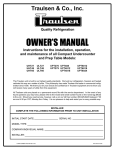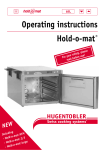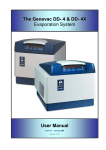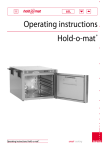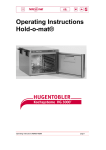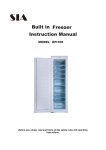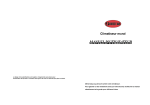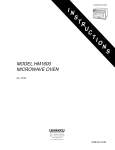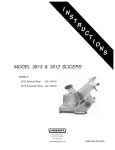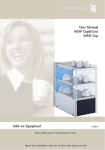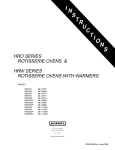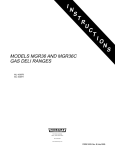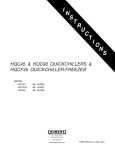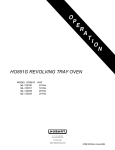Download Hobart Q Series User's Manual
Transcript
I N S T R U C T Q SERIES REACH-IN I O N S Q SERIES REACH-IN FOOD STORAGE CABINETS 701 S. RIDGE AVENUE TROY, OHIO 45374-0001 937 332-3000 www.hobartcorp.com FORM 14580 Rev. L (Jan. 2002) Installation, Operation and Care of Q SERIES REACH-IN FOOD STORAGE CABINETS SAVE THESE INSTRUCTIONS GENERAL The Q Series Reach-In Food Storage Cabinets are available as low temperature (0°F), medium temperature (38°F) refrigeration units or hot food storage cabinets (180°F maximum). They may be ordered as one-, two-, or three-section cabinets. A variety of optional cabinets is available. These include: Two- or three-section cabinets with a combination of medium and low temperature sections or medium temperature and hot food storage sections; two- or three section cabinets equipped with optional SAFE-T-THAW® equipment for safe, rapid thawing at medium temperatures; convertible models which, by setting a selector switch, will operate as either a low temperature or medium temperature unit; and single-section over/under cabinets which feature a medium temperature and a low temperature unit, one on top of the other. INSTALLATION UNPACKING AND ASSEMBLY Immediately after unpacking the reach-in, check for possible shipping damage. If this unit is found to be damaged after unpacking, save the packaging material and contact the carrier within 15 days of delivery. Prior to installation, test the electrical service to assure that it agrees with the specifications on the machine data plate located in the upper left corner inside the cabinet. LOCATION For optimum performance, the condensing unit of the reach-in (refrigeration models only) must have an adequate supply of air for cooling purposes. The operating location must provide either a minimum 12" clearance overhead of the condensing unit or the unrestricted flow of air at the back of the reach-in. –2– MOUNTING SCREW ASSEMBLY ASSEMBLY MOUNTING SCREW Some components can be removed to allow the cabinet to pass through short or narrow doorways. HANDLE ASSEMBLY SCREW The door handle can be removed as follows: PLUG BUTTON BOLT 1. Remove the screw and bolt from the tumbler. 2. Remove the two mounting screws and the handle assembly (Fig. 1) DOOR PL-50949 KEY 3. Replace in reverse order of disassembly. Fig. 1 Door(s) and hinges can be removed as follows: UPPER HINGE 1. Lift up and remove the front trim panel (Fig. 1). FRONT TRIM PANEL 2. Remove the screws which secure the trim rail cover (Fig. 1), unplug the door switch lead wires, and remove the screws which secure the trim rail (Fig. 1). Carefully lay the trim rail on top of the cabinet — avoid damaging or kinking the thermometer capillary tube. 3. Remove the three screws which secure the upper hinge plate to the cabinet (Fig. 2). This will remove hinge tension. Remove the nut underneath the lower hinge plate which secures the bottom hinge. Remove door. Remove lower hinge plate (Fig. 2). LOWER HINGE TRIM RAIL COVER SCREWS (3) PL-53615 4. If the hinge mechanism should become uncocked while changing the door, it will be necessary to recock the hinge mechanism. To do this, remove the door from the cabinet and position the door face down on a workbench or table. Using a 5/16" open end or adjustable wrench, turn the hinge mechanism shaft 135° (Fig. 3). Fig. 2 Fig. 3 UNCOCKED POSITION COCKED POSITION TURN 135º 135º – POSITION 1 – (LEFT-HAND HINGED DOOR) UNCOCKED POSITION 5. Replace the hinge plates and door(s) in the reverse order of disassembly. If cabinets are too tall, the refrigeration system may need to be removed in order to pass through short openings. Contact your dealer or authorized servicer if this becomes necessary. PL-53617 TRIM RAIL COCKED POSITION TURN 135º PL-50961 135º – POSITION 2 – (RIGHT-HAND HINGED DOOR) POSITION DOOR IN ONE OF THE TWO POSITIONS SHOWN. Fig. 4 Once the cabinet is in its final position, replace any components that may have been removed (door handle, etc.) and then level the cabinet front-to-back and side-to-side by adjusting the legs as required. Door Hinging Should the doors need to be rehinged (from right to left or vice versa), contact a Hobart-authorized Refrigeration Service Company. –3– LEGS OR CASTERS WARNING: THE CABINET MUST BE BLOCKED AND STABLE BEFORE INSTALLING LEGS OR CASTERS. THREADED HOLE Legs (Fig. 5) To install the legs, raise and block the reach-in a minimum of 7" from the floor and thread the legs into the Threaded Holes on the bottom of the cabinet. This unit must be level in order to operate properly. Turn the adjustable feet in or out as required to level the unit front-to-back and side-to-side. RAISE NOTE: Three-section front opening cabinets come with five legs, the fifth leg should be placed in the front center threaded hole. In the case of a three section pass through cabinet, a sixth leg is included for the rear center hole. Failure to install these legs in the proper location may result in damage to the cabinet. LOWER Fig. 5 PL-56125 Casters (Fig. 6) Use casters only on reach-in models with self-contained refrigeration systems that have cord and plug electrical connections. Raise and block the cabinet a minimum of 7" from the floor. Thread the casters into the holes in the bottom of the cabinet (Fig. 2). Casters with brake should be installed at the front. Securely tighten the caster with the octagon shaped Bolt head underneath — not the round flange on top. BOLT PL-53353 Fig. 6 PILASTER Shelves (Fig. 7) If purchased, the shelves and shelf clips are shipped with the cabinet. Insert the shelf clips into the pilaster and install the shelves. Index holes are provided in the pilaster to help in leveling the shelves. COLD AIR DUCT Bonus shelves are provided to fill the space between the shelves. These are positioned and supported by the shelves. NOTE: Loosen all thumbscrews which secure shelf pilasters and light cover(s) prior to placing product in cabinet. Thumbscrews should be loose enough to remove with your fingers so parts can be readily removed for cleaning without the use of tools. Failure to comply with this request will invalidate the NSF listing. BONUS SHELF INDEX HOLE SHELF CLIP SHELF PL-50910 Fig. 7 Utility Base (Optional) If your unit comes with a utility base, we recommend securing the base to the floor to prevent damage to the floor outlet due to accidental movement. The utility base is secured to the cabinet with four bolts, one at each corner. The utility base is mounted at the factory. With the cabinet in its final installed and leveled position, apply a bead of NSF approved sealant (not supplied) around the bottom. Access covers, secured with screws, are provided on the left side and front for attaching the power supply cord to a floor outlet underneath the cabinet. Curb The cabinet may be installed on a curb without legs or casters; the typical curb must be recessed a minimum of 13/8" from the front of the cabinet (and rear if it is a pass through) to allow room for the hinges. –4– Compressor Mounts Some Q Series units have the compressor specially mounted to help prevent damage during shipment. If the compressor is mounted on shipping blocks, remove the shipping blocks before operating the compressor. If the compressor is mounted on springs, refer to the tag attached to the compressor. Condensate Evaporator Q Series cabinets, except for remote or over/under units, are equipped with an automatic condensate evaporator and require no drain connection. ELECTRICAL CONNECTIONS (Cord Connected Reach-Ins) 120 Volt, 60 Hertz, 1 Phase WARNING: THIS MACHINE IS PROVIDED WITH A THREE-PRONGED GROUNDING PLUG. THE OUTLET TO WHICH THIS PLUG IS CONNECTED MUST BE PROPERLY GROUNDED. IF THE RECEPTACLE IS NOT THE PROPER GROUNDING TYPE, CONTACT AN ELECTRICIAN. ELECTRICAL CONNECTIONS (Permanently Connected Reach-Ins) WARNING: ELECTRICAL AND GROUNDING CONNECTIONS MUST COMPLY WITH THE APPLICABLE PORTIONS OF THE NATIONAL ELECTRICAL CODE AND/OR OTHER LOCAL ELECTRICAL CODES. WARNING: DISCONNECT ELECTRICAL POWER SUPPLY AND PLACE A TAG AT THE DISCONNECT SWITCH INDICATING THAT YOU ARE WORKING ON THE CIRCUIT. Make electrical connections per the wiring diagram supplied with the unit. PRESTART CHECKS REFRIGERANT LINES — Check for tubing shifts due to shipping that would cause operating noise, wear or leaks. SELECTOR SWITCH (Convertible Models Only) — The selector switch should be set to the proper position. To gain access to the switch, remove the front trim panel (Fig. 2) by raising it up (to clear the retaining slots) and out. Set the switch on the proper position (Refrigerator or Freezer) and replace the trim panel. OPERATIONAL CHECK — The refrigeration and defrost cycles should be checked for proper operation and the thermometer(s) should also be checked for correct temperature indication — before product is stored in the cabinet. DEFROST TIMER — On freezer units, set the defrost timer as described in Operation. OPERATION CONTROLS (Refrigeration) TEMPERATURE CONTROL — The temperature control is set at the factory but local conditions may necessitate slight adjustment. To adjust the temperature control, lift up and remove the front trim panel (Fig. 2). Turn the control knob (Fig. 8) a small amount at a time. Turning the control knob in the direction of the arrow lowers the temperature. The control knob has a marked OFF position which interrupts power to the compressor and condenser fan only, not the entire reach-in. TEMPERATURE CONTROL NOTE: Over/under units have separate temperature controls for each refrigeration system. They are located on the front of each evaporator housing. PL-56151 Fig. 8 –5– STANDARD THERMOMETER (Fig. 9) — The standard digital thermometer is calibrated at the factory and does not permit recalibration. OPTIONAL DIAL THERMOMETER — The optional dial thermometer can be recalibrated. Compare the cabinet thermometer with an accurate test thermometer. If there is any variation, contact a Hobart-authorized Refrigeration Service Company. Refr igera tor PL-50767 Fig. 9 CONTROLS (Safe-T-Thaw Only) The optional Safe-T-Thaw adaptation of the two- or three- section reach-in refrigerators significantly reduces the defrost time of all frozen foods under a controlled environment without employing temperatures over 45°F. Safe-T-Thaw incorporates a two stage thermostat, a reversing valve on the refrigerant line, and multiple fan units for increased internal air circulation. When non-frozen food is placed in the Safe-T-Thaw unit, it operates as a normal refrigerator — the thermostat switches cooling on at 40°F and off at 36°F. When a sufficient load of frozen food is placed in the cabinet to lower the temperature to 33°F, the heating mode is activated. The two stage thermostat will switch the circulating fans on and reverse the refrigerant valve so the warm refrigerant flows to the inside of the cabinet and the cool refrigerant goes to the outside coil. When the cabinet has warmed to 40°F the thermostat turns off the warming. The cabinet continues to cycle heat on at 36°F and off at 40°F. When the frozen product has lost its ability to reduce the cabinet temperature to 36°F, heat from the fan motors will gradually cause the cabinet temperature to climb to 45°F. At this point the thermostat will reverse mode again to normal refrigeration cycle — cooling on at 40°F and off at 36°F. Circulating fans do not work during normal refrigeration mode. All the apparatus works automatically without adjusting the factory settings. NOTE: To reduce the drying effect of the fans blowing air over foods, it is recommended that food stored in the Safe-T-Thaw be covered. CONTROLS (Hot Food Storage Units, Fig. 10) The ON-OFF switch contains a pilot light which glows whenever the switch is ON. Turn the switch OFF whenever the cabinet is not in use. The ON-OFF switch is not a disconnect switch — ALWAYS DISCONNECT POWER AT THE SOURCE TO SERVICE THE UNIT. The temperature control dial, which has a marked OFF position (no heat), is used to select the temperature at which the food will be held. When this dial is OFF, the air circulating fans continue to run. The HUMIDITY control dial is used to regulate the humidity level inside the cabinet. Three-section cabinets have two HUMIDITY control dials. –6– Fig. 10 ELECTRONIC DEFROST TIMER (when equipped) If your freezer is equipped with an electronic Defrost Timer, it is located in a control box behind the trim rail at the top of the Reach-In Freezer. To access the the Defrost Timer, remove the Thumbscrew on the left side of the Control Box and slide the Lid to the left (Fig. 11). Save the Thumbscrew and Lid and put them back in place after programming is done. THUMBSCREW LID CONTROL BOX PL-41628-1 Fig. 11 The Defrost Timer's clock is operating from the backup power supply (battery) during shipping and before installation. Once the freezer is plugged in, the Defrost Timer operates off of the AC power supply; the battery is only used during a power interruption or outage. This battery is a permanent type that is not replaceable except by replacement of the defrost timer itself. For additional information on behavior of the defrost timer if the battery loses power, refer to page 11. When the AC power is plugged in, the defrost time clock automatically switches the battery to a standby condition. When the Freezer is connected to the AC electrical power supply, the SET CLOCK light on the Defrost Timer (Fig. 12) blinks rapidly to indicate that the Defrost Timer is in normal Operation Mode. The Defrost Time Clock is set at the factory to the current timeof-day for Central Standard Time. The Defrost Duration is preset at the factory to run for 25 minutes. Also, the Defrost Schedule is preset at the factory to start a defrost cycle four times each day, at 2 AM, 8 AM, 2 PM and 8 PM. The factory preset defrost schedule is active during normal Operation Mode if all 24 switches are OFF. Switches are OFF when tabs are positioned to the left (Fig. 12). Fig. 12 The backup power supply (battery) maintains the correct time-ofday during shipping. If the freezer stays in the Central Time Zone, the time-of-day does not need to be reset. If the freezer is installed in a different time zone, the time clock can be reset to the correct time-of-day if desired. Refer to Setting the Time Clock to the Current Time-of-Day (page 8). PROGRAMMING THE ELECTRONIC DEFROST TIMER Use a small probe such as a pen, pencil or screwdriver to move the switches during programming. Switches are OFF when the tab is left, ON when tab is moved to the right. Before programming, if the initial switch settings are not all off (Fig. 12), make a record of the current switch settings on a piece of paper; this indicates the current defrost schedule. Then slide all 24 switches to the left or OFF position (Fig. 12). During programming, all settings must be completed within 4 minutes or the timer will return to normal Operation Mode. Once programming is done, restore the previous defrost schedule by returning the switches to the same positions noted on your record. –7– To Change the Defrost Duration and Bypass the Setting of the Time Clock Begin with the SET CLOCK light blinking rapidly, indicating normal Operation Mode . . . If you want to change the Defrost Duration but not reset the time-of-day, press and hold the PROGRAM button for about 3 seconds until the PROGRAM light starts blinking. Release the PROGRAM button and the PROGRAM light and the SET CLOCK light remain lit. Press and hold the PROGRAM button again until the DEFROST ON light starts blinking. Release the PROGRAM button and the DEFROST ON light remains lit. Skip the section titled Setting the Time Clock to the Current Time-of-Day (below) and continue with Setting the Defrost Duration (bottom of this page). Setting the Time Clock to the Current Time-of-Day Begin with the SET CLOCK light blinking rapidly, indicating normal Operation Mode . . . • Begin with all switches OFF (Fig. 12). • Press and hold the PROGRAM button for about 3 seconds until the PROGRAM light starts blinking. Release the PROGRAM button and the PROGRAM and the SET CLOCK lights remain lit. • The upper set of switches sets the HOUR. Slide the switch that corresponds to the current hour to the right. The 11 other switches remain OFF. • The lower set of switches sets the MINUTES. Find the switch that is within 5 minutes of the current minutes and move it to the right. At least 10 of the other switches in the lower set remain OFF. If the time is 0 to 3 minutes after the hour, all 11 switches can remain OFF. • The last switch of the lower set of switches selects AM or PM. Leave the tab on the left for AM. Slide the tab to the right for PM. Fig. 13 The example, Fig. 13, sets the Time Clock at 2:45 PM. Press and hold the SET button until the SET CLOCK light starts blinking. Release the SET button; the SET CLOCK light goes off and the DEFROST ON light begins to blink and then remains on. Continue with Setting the Defrost Duration. To exit without setting the Defrost Duration, return all switches to the left, press the PROGRAM button for three seconds and release the PROGRAM button — normal Operation Mode returns with the SET CLOCK light blinking rapidly. Setting the Defrost Duration The Defrost Duration was preset at the factory for 25 minutes. Depending on freezer usage and your defrost schedule, you may choose to customize the Defrost Duration. The usual and recommended Defrost Duration setting is 25 minutes. Complete either the section titled To Change the Defrost Duration and Bypass the Setting of the Time Clock or complete the section titled Setting the Time Clock to the Current Time-of-Day before continuing. With the PROGRAM and the DEFROST ON lights lit . . . • Move all 24 switches to the left or OFF position. • In the lower set of switches, move the one switch to the right that corresponds to the desired Defrost Duration (nearest 5 minutes). The example, Fig. 14, sets the Defrost Duration at 30 minutes. Press and hold the SET button until the DEFROST ON light starts blinking. Release the SET button and the SET CLOCK light flashes rapidly indicating that the timer has returned to normal Operation Mode. To verify that the clock and the defrost duration are set properly, perform Program Review (page 10). –8– Fig. 14 How to Set a Custom Defrost Schedule Begin with the defrost timer on normal Operation Mode: The SET CLOCK light is blinking rapidly and the PROGRAM and DEFROST ON lights are off. If all switches are OFF (Fig. 15), the factory preset defrost schedule is enabled: 2 AM, 8 AM, 2 PM, 8 PM. • Determine your own best defrost schedule. The upper set of switches represents the AM hours; the lower switches represent the PM hours. Allow a minimum of 2 hours between the start of any two defrost cycles. • To customize your defrost schedule, begin with all switches OFF (Fig. 15). • With the SET CLOCK light blinking rapidly, as in normal Operation Mode, slide the switches to the right that correspond to the hour when each defrost cycle should begin. • If you want a defrost cycle to begin on the half-hour, slide the two adjacent switches to the right. For example, to start a defrost cycle at 2:30 PM, Slide switches 2 and 3 to the right in the lower set of switches. Custom Defrost Schedule Example #1 (Fig. 16) shows five defrost cycles that begin at 1 AM , 6 AM, 10 2:30 PM and 8 PM. AM , Custom Defrost Schedule Example #2 (Fig. 17) shows six defrost cycles that begin at 1 AM, 4 AM, 10 2:30 PM, 6 PM and 9:30 PM. AM , During normal operation, leave these switches set on the desired defrost schedule if it is other than the factory preset schedule. ALL SWITCHES OFF GIVES YOU THE FACTORY PRESET DEFROST SCHEDULE: 2:00 AM, 8:00 AM, 2:00 PM, 8:00 PM Fig. 15 CUSTOM D EFROST SCHEDULE EXAMPLE #1: 1:00 AM, 6:00 AM, 10:00 AM, 2:30 PM, 8:00 PM CUSTOM DEFROST SCHEDULE EXAMPLE #2: 1:00 AM, 4:00 AM, 10:00 AM, 2:30 PM, 6:00 PM, 9:30 PM Fig. 16 Fig. 17 –9– Program Review During normal Operation Mode, with the SET CLOCK light blinking rapidly . . . Current Clock Time = HH:MM # Blinks = HH # Blinks (times 5) = MM Press the SET button until the SET CLOCK, PROGRAM, and DEFROST ON lights are lit; then release the SET button and all three lights go off for two seconds. After that, all three lights begin to blink. The number of blinks of a light corresponds to the programmed value for that light. A three second pause follows the last blink before the cycle repeats. The Review Mode's sequence of blinking lights (Fig. 18) repeats ten times to give you plenty of chances to count the number of blinks for each light. Review Mode can be stopped at any time by pressing the SET button for 3 seconds; when the SET button is released, normal Operation Mode returns with the SET CLOCK light blinking rapidly. The SET CLOCK light blinks from 1 to 12 times to indicate the TIME CLOCK HOUR. If the final blink for the hour count remains on for two seconds, it indicates PM; if the final blink for the hour count is a normal blink, it indicates AM. While the SET CLOCK light is blinking the HOUR, the PROGRAM light blinks from 0 to 11 times to indicate the TIME CLOCK MINUTES to the nearest 5 minutes after the hour: 0 blinks = 0 minutes, 1 blink = 5 minutes, 2 blinks = 10 minutes, . . . 11 blinks = 55 minutes. # Blinks (times 5) = DEFROST DURATION Fig. 18 While the SET CLOCK light is blinking the HOUR and the PROGRAM light is blinking the MINUTES, the DEFROST ON light blinks from 0 to 11 times to indicate the DEFROST DURATION setting to the nearest 5 minutes: 0 blinks = 0 minutes, 1 blink = 5 minutes, 2 blinks = 10 minutes, . . . 11 blinks = 55 minutes. After the ten blinking sequences are done or after Review Mode has been stopped, normal Operation Mode returns with the SET CLOCK light blinking rapidly. Initiating a Manual Defrost During normal Operation Mode, with the SET CLOCK light blinking rapidly . . . Press the MANUAL DEFROST button for about 3 seconds until the DEFROST ON light comes on. The Defrost Cycle is started and continues for the amount of time programmed for DEFROST DURATION (page 8). Cancelling a Defrost Cycle While a Defrost Cycle is in progress, the DEFROST ON light is lit. A Defrost Cycle that is in progress can be terminated by pressing the MANUAL DEFROST button for 3 seconds. The DEFROST ON light goes off. The normal DEFROST SCHEDULE continues to operate as programmed. – 10 – If the Defrost Timer's Battery Loses Power If the SET CLOCK, PROGRAM and DEFROST ON lights are all blinking, the backup power supply (battery) to the Defrost Timer has weakened. Estimated battery life is 10 years. The timer can continue to function normally after the battery has weakened if the timer is reprogrammed. If a power outage occurs and is later restored after the battery has weakened, the following three things happen: • The defrost clock resumes as if it were 12:00 midnight. • The position of the switches dictates the defrost schedule. If all switches are OFF, the factory preset times of 2 AM , 8 AM, 2 PM and 8 PM will initiate deftost cycles 2, 8, 14 and 20 hours after power was restored. • The factory preset defrost duration of 25 minutes is re-invoked. Because the clock resumed at 12:00 midnight, it must be reset to the current time-of-day to avoid inconvenient defrost cycles. Refer to Setting the Time Clock to the Current Time-of-Day (page 8). If the Defrost Duration was set at a value other than the factory preset 25 minutes, reset it. If power is lost again, reset again. Refer to Setting the Defrost Duration (page 8). If you are using a custom Defrost Schedule, the switches must be reset after resetting the time and Defrost Duration. Any defrost start times that are set by the positions of the program switches will override the factory preset defrost start times even if the battery is weakened. If the battery has weakened and reprogramming the time-of-day, defrost duration and schedule after a power interruption is too inconvenient, the Electronic Defrost Timer can be replaced. In the event of a power surge or lightning, the SET CLOCK, PROGRAM and DEFROST ON lights will all blink the same as for a weak battery but the battery may not have weakened. First, try to reprogram the Defrost Timer. If the Defrost Timer fails to function normally, contact service. MECHANICAL DEFROST TIMER (Fig. 19) When equipped on Freezers or on Convertible Models with Freezer Chambers, when power is initially applied to the cabinet, the exterior dial of the defrost time clock must be set to the correct time of day. To access the defrost timer, remove the front trim panel (Fig. 2) by lifting up and out. Open door on the defrost timer box. Turn the inside knob counterclockwise until the exterior dial is positioned so the correct time of day is at the time of day pointer. Replace the front trim panel when done. TIME-OF-DAY POINTER EXTERIOR DIAL (24 HOUR) TURN KNOB COUNTERCLOCKWISE DEFROST CYCLE PINS The defrost timer (Fig. 19) is set at the factory for four 26-minute defrost cycles per day (2 AM, 8 AM, 2 PM and 8 PM). Depending on local conditions, it may be necessary to change the frequency or duration of defrost cycles. If the power supply is interrupted, the defrost timer must be reset to the correct time of day. END DEFROST (26 MINUTES) BEGIN DEFROST PL-41397-1 Fig. 19 – 11 – MAINTENANCE CLEANING Cabinet Clean the inside of the cabinet and the doors weekly with a warm water solution of mild household liquid dishwashing detergent (such as Palmolive green or Ivory). Do not use anything containing grit, abrasive materials, bleach or harsh chemicals. Be cautious with new or improved formulas; use only after being well tested. Rinse thoroughly and dry with a clean soft cloth. Gaskets Door gaskets should be cleaned weekly using a warm water solution of mild household liquid dishwashing detergent (such as Palmolive green or Ivory). Never allow gaskets to contact concentrated cleaners or disinfectants. This can cause premature failure of the gasket material. Condenser Coil WARNING: DISCONNECT ELECTRICAL POWER SUPPLY BEFORE CLEANING THE CONDENSING UNIT. Check the condenser coil weekly. This surface must be kept free of dirt and grease for proper system operation. Remove the front trim panel and carefully vacuum or brush dirt and lint from the condenser coil. Replace the trim panel. Evaporator Coil, Drain Pan, Condensate Loop and Condensate Dish When needed, flush these components with fresh water. This should be a part of any routine maintenance program and can prolong the life of the equipment. Light Bulb Replacement (when equipped) Replace light bulb(s) with 40 watt incandescent appliance type bulb(s) ONLY. The protective cover can easily be removed and replaced. Florescent Light Bulb Replacement (when equipped) Remove protective cover. Replace florescent tube with same size and type: 40 watt, 48" long. TROUBLESHOOTING SYMPTOM POSSIBLE CAUSE Unit fails to operate. Power failure. Plug loose in receptacle. Blown fuse or tripped circuit breaker. If a freezer model is in a deftost cycle, wait 30 minutes and recheck. Check the Temperature Control (page 5 or 6) to make sure it is not OFF. If the suggestions above fail to remedy the situation, contact service. WARRANTY The Q series cabinet warranty is for two years. It includes parts, labor and travel during normal working hours in the continental United States. The non-prorated compressor warranty is for an additional three years and does not include labor. For additional information or to discuss a maintenance program, contact your local authorized refrigeration servicer. FORM 14580 Rev. L (Jan. 2002) – 12 – PRINTED IN U.S.A.












